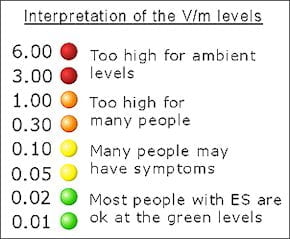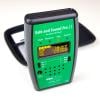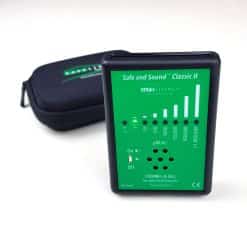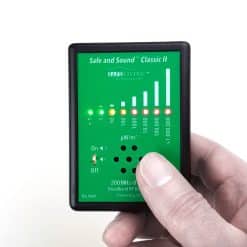Acousticom 2 – EMFields Elektrosmog måler (HF)
1.475 kr.
Ikke på lager
Brugervenligt apparat til måling af højfrekvent/radiofrekvent stråling (HF/RF)
Denne lille måler er perfekt til dig der ønsker at måle HF/RF stråling fra trådløse teknologier, og ønsker en måler der er ekstremt nem at betjene, men stadig kompetent og pålidelig. Måleren dækker frekvensområdet 200 MHz – 8 GHz, hvilket inkluderer nuværende 5G frekvenser, og den indeholder den samme avancerede mikrobølgedetektor som EMFields roste (og væsentligt dyrere) Acoustimeter.
Med sine ca. 11 x 6 x 2 cm er måleren meget praktisk og nem at have med på farten. Den leveres med et formonteret 9V batteri, samt en bæretaske.
RF måleren farmor kan betjene
Måleren tændes ved et enkelt tryk på knappen, og måleværdien vises i V/m ved hjælp af en række lysdioder. Målingen er 1-akset, hvorfor man skal dreje måleren for at finde den højeste værdi.
Lyden aktiveres ved et ekstra tryk på knappen, hvorved man kan høre hvilken type af signaler det er man måler. Med lidt træning lærer man ud fra lydbilledet at skelne mellem fx wifi, mobilmaster, DECT, TETRA osv. Der er også en alarm ved høje niveauer af RF. Du kan enkelt slukke for lyden, hvis du foretrækker at være diskret når du foretager målinger.
For flere detaljer venligst se producentens engelske varebeskrivelse længere nede på siden.
Acousticom 2 demo video

Læs mere om EMFields Acousticom 2 - Elektrosmog måler (HF)
Description
The Acousticom 2 presents RF measurements as an audio signal, with LEDs and an alarm at high levels of RF (you can also switch the sound off if you prefer to be less obvious when taking readings). With simple controls, easy to read results, but still using the same advanced microwave detector as our Acoustimeter, this instrument is perfect for those on a budget. It is smaller and lighter than the Acoustimeter, and comes in its own carry pouch.

When first turned on the Acousticom 2 is silent. The sound may be turned on and off by pressing the button. The Acousticom 2 also has an “alarm” sounder which emits a pulsing warning at higher exposure levels. If the alarm is not required, then it is easy to disable it each time when you turn the Acousticom 2 on. The demodulated sounds allow you to determine, with a small amount of practice, what type of device is creating the pulsing microwave levels that are present. These features make the instrument the most useful and practical one available – even for people with severe electrosensitivity.
The Acousticom 2 reacts to very short pulses. Peak readings are what they say – the highest sampled reading – though the sampling and processing rate means that there are some gaps and it will not always react to a SINGLE VERY short pulse (less than about 5 microseconds duration) – though it will react correctly to much shorter pulses that are regularly transmitted (such as from WiFi).
Please note: The internal antenna is at the upper half of the case and the back. Signals are best measured when the source is behind the instrument, but also quite good with the source to one or other side. Turn the Acousticom 2 for the highest reading.
Technical specifications
- A line of coloured LEDS displaying Peak exposure levels in V/m
- Measurement range: 200 – 8 000 MHz ±6 dB (typical accuracy)
- Sensitivity (Peak Display): 0.01 – 6.00 volts per metre (V/m)
0.01 / 0.02 / 0.05 / 0.1 / 0.3 / 1.0 / 3.0 / 6.0 V/m;
(equivalent to 0.5 to 100,000 peak µW/m2) - Some intermediate points when two LEDs are both lit are also defined: 0.2 / 0.6 / 2.0 / 4.5 V/m
- The speaker may be switched on and off
- An alarm sounder at higher exposure levels (may be disabled)
- Power source: 1x PP3/MN1604 9 volt Alkaline or Rechargeable
- Battery life: Up to 10 hours continuous with normal alkaline battery
- » Low battery indicator light (the green ‘on’ light turns red)
- Size (mm): 110 x 63 x 21 (LxWxD); Weight: 140g incl. battery
Further information
Engelsk brugervejledning (PDF)
The Acousticom 2 was designed using the experience gained from many years of practical RF and microwave measurements. The advanced RF detector is the same as that used in the Acoustimeter. LED lights display the peak levels of microwave electromagnetic fields from 200 MHz up to over 8000 MHz (8 GHz), covering the frequencies used by most modern communication systems encountered in our everyday environment. This includes TETRA, all mobile phone systems including 4G/LTE, current 5G installations, Smart Meters, and all WiFi and WiMax frequencies. The LEDs update rapidly, and allow you to quickly gauge the levels in an area and find any hot-spots. Its readout is sensitive to 0.01 V/m. When two LEDs are both lit next to each other, the exposure level is halfway between the two. This is only for levels above 0.1 V/m, e.g. when both 0.10 and 0.30 V/m are lit, the level is about 0.20 V/m (halfway between).
| Vægt | 200 g |
|---|---|
| Dimensioner | 110 × 63 × 21 cm |















